In recent years, the business world has been abuzz with terms like “digital transformation” and “digital strategy.” These concepts, once groundbreaking, have saturated corporate dialogues to the point of becoming clichés. However, it’s time we move beyond these buzzwords and rethink our approach to integrating digital technology into business. Here’s why and how.
Table of Contents
ToggleWhat Actually Is Digital Transformation?

So, you’ve heard about this thing called “digital transformation,” right? Well, buckle up because defining it is like trying to nail jelly to the wall. Trust me, it’s the Loch Ness Monster of the business world – everyone talks about it, but no one’s quite sure if it’s real or just a fancy myth.
Now, what exactly is a digital transformation? The answer is simple: absolutely no one has a clue. It’s like asking what the fox says – theories abound, but the truth remains elusive.
But let’s give it a shot. In the most unhelpful terms possible, digital transformation is… well, it depends. It’s like your grandma trying to use a smartphone – the outcome will vary wildly based on the starting point. It’s all about the organization’s current state and goals. If your company is still operating like it’s 1999, then digital transformation might just mean getting an email address that doesn’t end in @aol.com.
The term “transformation” is key here. It’s not just a digital “change” or a digital “slight alteration.” No, no, it’s a full-blown, caterpillar-to-butterfly, Clark-Kent-to-Superman kind of deal. But remember, just like in those nature documentaries, not every caterpillar makes it to butterfly status. Some end up stuck in the cocoon, which in business terms means getting tangled up in endless Zoom meetings about what digital transformation should look like.
In summary, digital transformation is a bit like your horoscope – vague, ever-changing, and open to interpretation. Just slap the term on any project that involves a computer, and voilà, you’re a digital transformer! (Disclaimer: Actual results may vary, batteries not included.)
The Issue with Buzzwords

If you follow our Digital Stratosphere or Transformation Ground Control podcasts, you know that I absolutely love buzzwords. But there is a dark side to overused terms. They lose impact and lack a clear vision and understanding.
The Pitfalls of Overused Jargon
- Loss of Meaning: When terms like digital transformation become overused, they lose their specific meaning. Every company’s digital journey is unique, and lumping these varied experiences under a single term dilutes its significance.
- One-Size-Fits-All Mentality: The idea of a universal digital strategy fails to consider individual organizations’ unique challenges and goals. What works for a tech giant may not be suitable for a small retail business.
- Complacency Risk: There’s a danger that once a company declares it has achieved ‘digital transformation,’ it may become complacent. In reality, the digital landscape is always evolving, and businesses must continuously adapt.
Digital transformation has had a good run. But honestly, I think it’s about time we moved on from it. It’s like that hit song that’s been overplayed on the radio – great at first, but eventually, you’re ready for a new tune. Sure, it had its moment in the spotlight, helping businesses enter the digital age. But now, it feels like we’re just hanging onto an old catchphrase. Let’s ditch the jargon and focus on what’s really important: staying adaptable and innovative in this ever-changing digital landscape. What do you think?
Business Transformation is In.

Digital transformation has definitely outgrown its initial tech-centric cocoon. It’s not just about the digital or technological aspect anymore. We’re talking about a comprehensive business transformation here. It’s like realizing that upgrading your phone isn’t just about a fancier camera – it’s about how you communicate, work, and even relax.
Similarly, for businesses, digital transformation has become a whole new way of operating, strategizing, and engaging with customers. It’s no longer just about adopting new technologies; it’s about rethinking business models, processes, and even the company culture to stay competitive and relevant in today’s fast-paced world. It’s a game-changer, really.
A New Perspective on Digital Integration
- Customized Digital Evolution: Instead of striving for a one-off transformation, businesses should focus on a continual evolution tailored to their specific needs and goals. This approach acknowledges that digital integration is an ongoing process.
- Emphasizing Agility and Innovation: The new mantra should be about fostering an environment of agility and innovation. Companies should encourage experimentation and be open to adopting new technologies that align with their evolving needs.
- Human-Centric Technology Approach: Rather than getting caught up in technology for its own sake, the focus should shift to how these digital tools can improve human experiences, both for customers and employees.
- Sustainability and Ethical Considerations: As businesses adopt new technologies, they should also consider the ethical implications and sustainability. This includes data privacy, environmental impact, and the social consequences of technological adoption.
Enter Digital Enterprise Operations
We intentionally named our marquee report the ‘Digital Enterprise Operations Report‘ because we’ve noticed a concerning trend in our network and among our clients. Many were either confining their digital projects solely to their technical teams or overlooking operational excellence’s crucial role in effectively leveraging technology.
We saw these practices as a significant misstep. By siloing digital initiatives within technical departments, businesses were missing the opportunity to integrate these advancements into their broader operational strategies. It’s not just about having cutting-edge technology; it’s about how this technology is woven into the very fabric of our daily operations.
Furthermore, we recognized the necessity of operational excellence in the effective use of technology. It’s one thing to acquire new digital tools, but it’s entirely another to integrate them seamlessly into our operational workflows, maximizing their potential and impact on our business.
Therefore, in naming our report the ‘Digital Enterprise Operations Report,’ we’re making a clear statement: digital transformation is not merely a technological upgrade. It’s a comprehensive, organization-wide evolution encompassing every aspect of how we operate, grow, and compete in this digitally-driven business landscape.
The Importance of Operational Excellence
Picture this: You’ve got the shiniest, sparkliest, most whiz-bang technology out there. It’s like the Rolls-Royce of gadgets, the caviar of computing, the… well, you get the idea. But without solid operations to back it up, this tech marvel is just a glorified paperweight collecting dust in your back room.
It’s like having a spaceship but no astronaut training – sure, it looks cool, but you’re not going anywhere fast. Fancy tech without operational savvy is like a superhero without a cape – it might have the muscles, but it’s not going to soar!
Let’s dig into the critical importance of operational excellence in implementing new technology. It serves as the bridge between new technological capabilities and their effective application in a business context. Here’s why it’s so crucial:
- Maximizing Return on Investment: New technology often requires significant investment. Operational excellence ensures that this investment is not just a cost but a catalyst for efficiency, productivity, and ultimately, profitability. Without it, the most advanced technology might fail to deliver its intended value.
- Seamless Integration into Existing Processes: Introducing new technology isn’t just about the tech itself; it’s about how it fits into your current operations. Operational excellence ensures that new tools are integrated seamlessly with existing processes, enhancing rather than disrupting the workflow.
- Enhancing User Adoption and Competency: For any new technology to be effective, it must be embraced by its users. Operational excellence involves training and supporting staff in using new technologies, ensuring high adoption rates and competent usage. This approach minimizes resistance and maximizes acceptance and effectiveness.
- Ensuring Consistency and Quality: In the hustle of embracing new technology, consistency and quality of products or services must not be compromised. Operational excellence focuses on maintaining high standards during the transition, ensuring that the business continues to deliver value to its customers.
- Scalability and Future Growth: Operational excellence looks at the long-term implications of new technology. It ensures that the technology is scalable and can support future business growth. This foresight prevents the need for constant adjustments or replacements as the business evolves.
- Risk Management and Compliance: With new technology comes new risks, including security threats and compliance issues. Operational excellence includes implementing the right controls and protocols to manage these risks effectively and safeguarding the business and its data.
- Continuous Improvement and Innovation: Finally, operational excellence isn’t a one-time effort; it’s a continuous pursuit. It involves regularly evaluating the impact of new technology and looking for ways to improve and innovate, ensuring that the business stays ahead of the curve.
In summary, operational excellence when implementing new technology is about more than just the technology itself. It’s about ensuring that this technology is a strategic fit, is used effectively, and contributes to the overall success and growth of the business.
Interoperability

We’ve all heard the spaghetti bowl metaphor for a business technology stack. Just like a bowl of spaghetti, where every noodle seems to twist and turn around another in an endless, confusing maze, our technology systems can get just as intertwined and perplexing.
Each “noodle” in this tech-spaghetti is a different application or software tool, and before you know it, they’re all looped and tangled together. You pull one noodle, hoping to extract it neatly, but nope – you’ve accidentally brought half the bowl with it! Similarly, try changing one system in your business, and watch as it unexpectedly impacts three others. It’s like a high-stakes game of Jenga but with software.
This is where interoperability comes in.
Interoperability is the ability of different systems, devices, applications, or products to connect and communicate in a coordinated way, without extra effort from the user. It’s like having a group of friends who all speak different languages but still manage to have a great conversation using a universal translator.
In technology, interoperability is crucial because it allows different hardware and software systems to work together seamlessly. Imagine you have a smartphone from one brand, a laptop from another, and a smart home device from yet another. Interoperability is what allows these devices to share data and perform tasks together smoothly, regardless of their different manufacturers or operating systems.
In healthcare, for example, interoperability is about different systems and tools (like electronic health records) being able to exchange and interpret shared data. When systems are interoperable, a patient’s medical history can be easily shared among various doctors and specialists, improving the quality of care.
For businesses, interoperability is important for efficiency. It enables different departments and their respective tools and software to integrate their data and processes, making the business run more smoothly and reducing errors.
Overall, interoperability is all about making different systems work together in harmony, which is key in our increasingly connected world.
Why is Interoperability Important?
Interoperability is like the glue that holds the diverse elements of a tech ecosystem together, making it incredibly important for several reasons:
- Streamlined Communication: Imagine you’re at a United Nations meeting without translators – chaos, right? Interoperability is the translator that lets different systems and devices ‘talk’ to each other seamlessly. It ensures that data and information can flow smoothly between various technologies, making communication more efficient.
- Enhanced Productivity: It’s like having a well-orchestrated orchestra. When all instruments play in harmony, the music is beautiful. Interoperability aligns different tech tools and systems to work in unison, reducing the time and effort needed to manage them separately. This boosts productivity as tasks are completed faster and with fewer hiccups.
- Cost Efficiency: Imagine trying to fit a square peg into a round hole; it’s just a waste of time and energy. When systems are interoperable, organizations save money by reducing the need for custom solutions to make incompatible systems work together. It’s like having universal chargers for all your gadgets.
- Better Decision Making: Interoperability is like having all the pieces of a puzzle. When you can easily access and combine data from different sources, you get a complete picture. This comprehensive view supports better, more informed decision-making.
- Improved User Experience: Think of it as a seamless journey rather than a hurdle race. Interoperability offers users a smooth experience, as they don’t have to juggle between incompatible systems or struggle with data trapped in one application that’s needed in another.
- Innovation and Growth: It’s like giving chefs ingredients from around the world – they’ll cook up something incredible. Interoperability fosters innovation by making it easier to integrate new technologies and adapt to changing market needs.
- Safety and Compliance: Especially in critical fields like healthcare, interoperability can mean the difference between life and death. Sharing vital data across platforms can ensure timely, accurate, and safe patient care. It also helps in adhering to regulatory standards.
Interoperability truly is vital because it ensures that the diverse elements of our increasingly complex tech ecosystems can work together efficiently, paving the way for smoother operations, cost savings, better decision-making, enhanced user experiences, and continual innovation.
Interoperability and ERP
I hear what you’re saying. Isn’t the whole idea of rolling out an ERP (Enterprise Resource Planning) system to achieve seamless integration? Absolutely, that’s a big part of it. But here’s the twist: with the surge in specialized, ‘best of breed‘ systems, various customizations, and industry-specific applications, simply having an ERP system isn’t the end of the story. In today’s business landscape, an interoperability strategy becomes not just nice-to-have but a must-have.
It’s like having a universal remote control (your ERP system), which is great for standard operations. But then you start adding a bunch of fancy gadgets – a smart TV here, a state-of-the-art sound system there, maybe a gaming console – each with its own unique features and functions. To make the most of these advanced tools and ensure they all play nicely together, you need more than just the universal remote; you need a smart integration plan.
That’s where your interoperability strategy comes in, ensuring all these diverse systems work harmoniously and your business operates like a well-oiled machine.
We the People

Since it’s pretty much impossible for me to dive into a blog about digital transformation without talking about the people behind it, let’s jump right in. There’s this common misconception floating around that ‘digital’ transformation means it’s all about the systems and tech, with people just being an afterthought. But let me tell you, that’s about as far from the truth as possible.
On the other hand, business transformation is a term that more comprehensively encompasses the human element. The human component is absolutely crucial to the success of any technical implementation for several key reasons:
- User Adoption: At the end of the day, people use the technology. No matter how advanced or efficient a new system might be, its success hinges on whether people accept and use it. Without user buy-in and adoption, even the most sophisticated technology can end up underutilized or abandoned.
- Change Management: Implementing new technology isn’t just a technical challenge; it’s a change management one. People naturally resist change, especially when it affects their daily routines or comfort zones. Successful technical implementations involve guiding, training, and supporting users through this change, ensuring they understand and embrace the new technology.
- Feedback and Continuous Improvement: People using the technology provide invaluable feedback. They’re the ones who can point out glitches, suggest improvements, and help refine the system. This feedback loop is essential for continuous improvement and ensuring the technology meets the actual needs of its users.
- Cultural Fit: Every organization has its own culture and ways of working. Technology needs to fit into this culture to be effective. It’s not just about the technical capabilities of a new system but how well it aligns with the values, practices, and behaviors of the people in the organization.
- Skillsets and Training: Effective implementation of new technology often requires new skill sets. Investing in training and development ensures that employees are not only comfortable with the new system but also skilled in leveraging it to improve their work.
- Problem-Solving and Innovation: People are not just users of technology; they’re problem solvers and innovators. When they understand and engage with new technology, they can use it to create innovative solutions, streamline processes, and drive the business forward in ways that a purely technical approach cannot achieve.
- Emotional Intelligence and Human Insight: Machines and systems lack emotional intelligence and the nuanced understanding that humans bring. This human insight is critical in tailoring technology to serve customers better, enhance user experience, and make decisions that a purely data-driven approach might miss.
The human component is not just an add-on but a central aspect of any technical implementation. Ensuring the technology serves and is embraced by people, rather than just existing in a vacuum, is what ultimately determines its success.
Conclusion
It’s high time we move past the worn-out jargon of “digital transformation” and “digital strategy” and embrace a broader, more nuanced perspective. This approach should encompass the entire business landscape, focusing on operations and interoperability. By shifting our focus to a model of continuous evolution, where technology is centered around human needs, coupled with a strong commitment to ethical practices and adaptability, businesses can remain at the forefront in a fast-evolving digital world. So, as much as it pains me to say it, let’s leave the buzzwords behind and steer towards a future where technology is as vibrant and varied as the businesses it’s meant to revolutionize.
As I mentioned in this blog, I highly recommend downloading our 2024 Digital Enterprise Operations Report and following our weekly podcasts or YouTube channel for more on the holistic approach to business technology. Please also feel free to reach out to me directly at kyler.cheatham@thirdstage-consulting.com with any feedback or questions on this blog. My team and I are happy to be an informal soundboard for your project.





